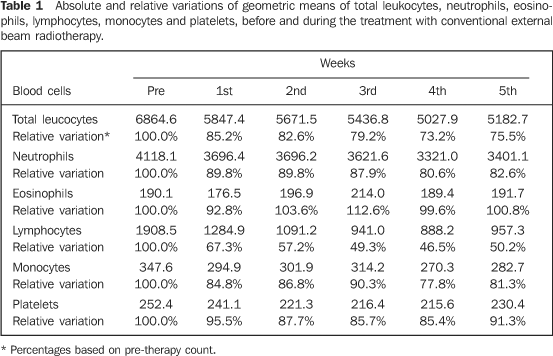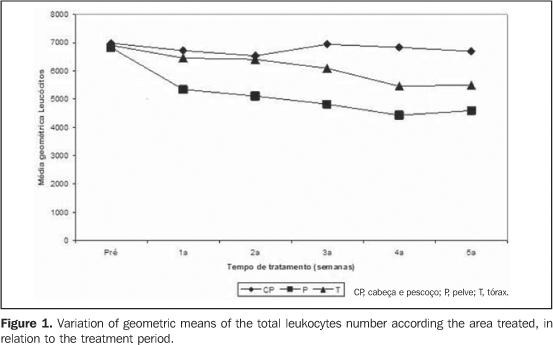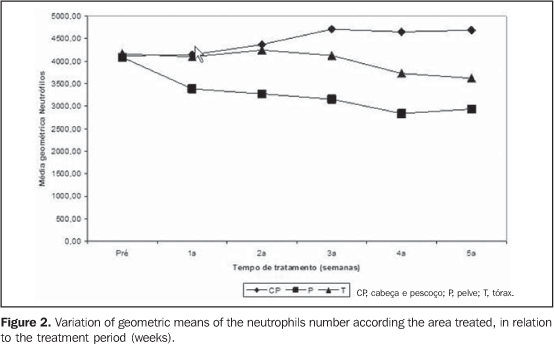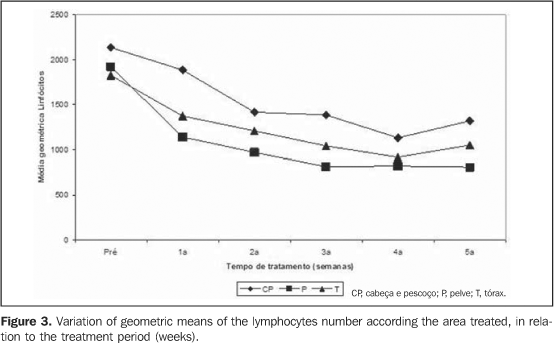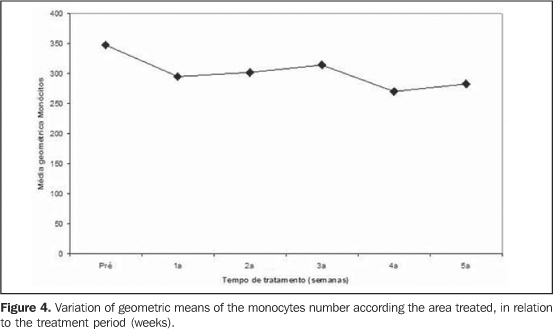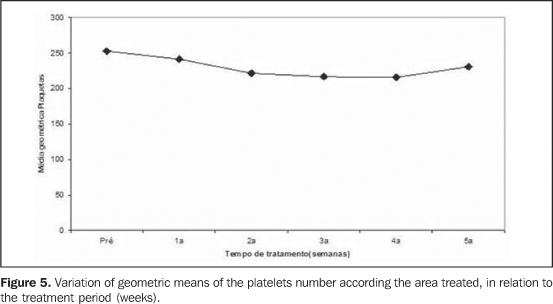Radiologia Brasileira - Publicação Científica Oficial do Colégio Brasileiro de Radiologia
AMB - Associação Médica Brasileira CNA - Comissão Nacional de Acreditação
 Vol. 41 nº 1 - Jan. /Feb. of 2008
Vol. 41 nº 1 - Jan. /Feb. of 2008
|
ORIGINAL ARTICLE
|
|
Weekly monitoring of the effects of conventional external beam radiation therapy on patients with head and neck, chest, and pelvis cancer by means of blood cells count |
|
|
Autho(rs): Maria da Salete Fonseca dos Santos Lundgren, Maria do Socorro de Mendonça Cavalcanti, Divaldo de Almeida Sampaio |
|
|
Keywords: Leukocyte count, Complete blood count, External beam radiotherapy, Radiotherapy toxicity |
|
|
Abstract:
IMaster in Medical Sciences, Head for the Radiotherapy Unit at Hospital Universitário Oswaldo Cruz, Recife, PE, Brazil
INTRODUCTION The series of alterations occurring in the hematopoietic system during and after conventional external beam radiation therapy covering localized areas of the bone marrow is similar to the alterations occurring during the whole bone marrow irradiation. However these alterations do not occur immediately and may arise weeks or even months following the radiotherapy(1,2). In the case of localized radiotherapy, the analysis of a medullary sample taken from the irradiated area of a patient does not reflect the conditions of his/her whole bone marrow, and the apparent injury to a part of the medullary function does not seem to be significant for the whole hematological condition. Some studies have demonstrated that peripheral blood count results were within the regular parameters at the moment of the localized medullary hypoplasia(3–5). Therefore, after radiotherapy, the medullary regeneration depends not only on the absorbed dose, but also on the amount of irradiated hematopoietic tissue. Few studies in the literature report the hematological effects when small irradiation fields are utilized, usually for treatment of localized cancer(6). Weekly peripheral blood counts have become a routine for patients undergoing radiation therapy, as a result of the hematopoietic system sensitivity and based on studies with whole-body irradiation.
MATERIALS AND METHODS The present study was developed in the period between March and October/2004, with 101 male and female patients > 21 years of age, affected by cancer of head and neck, chest and pelvis, with an area treated > 100 cm², in five weekly fractions at a daily radiation dose ranging between 180 cGy and 200 cGy (total dose = 4500 to 5000 cGy)(7–9), during five weeks. Highenergy X-radiation was delivered by a 6 MV Clinac 600C Varian linear accelerator, and the patients had their blood counts performed before and weekly during the treatment. Exclusion criteria were: patients previously or concomitantly submitted to chemotherapy; patients submitted to hypo- or hyper-fractioned radiotherapy, or multiple-site radiotherapy; patients with a known disease of the hematopoietic system; patients with an initial leukocytes count < 4000 cells/mm³; patients with an initial platelet counts < 150000 cells/mm³. Data analyses and comparisons were made on an Excel worksheet, and geometric mean was adopted as the measurement of the typical value for each type of blood cell, considering the remarkable asymmetry between data(10). Regression models for longitudinal data were adjusted to analyze the effects of variables such as patients' sex, mean age and area treated on the blood counts results, utilizing generalized estimation equations (GEE). All of the patients included in the sample of the present study signed a term of free and informed consent. The study was approved by the Committee for Ethics in Research of the Institution.
RESULTS Leukocyte and platelet counts (606 blood counts) of 101 adult patients (69 women and 32 men), with ages ranging between 29 and 85 years (mean age = 59.3 years, standard deviation = 12.6 years) were evaluated. All of the patients with tumors of head and neck (n = 11; 10.9%), chest (n = 35; 34.6%) and pelvis (n = 55; 54.5%), were submitted to conventional external beam radiotherapy. Relative and absolute values corresponding to the geometric means of total leukocytes, neutrophils, eosinophils, lymphocytes, monocytes and platelets before the radiotherapy (pre-treatment) and during the treatment (first, second, third, fourth and fifth weeks) of the patients with cancer of head and neck, chest and pelvis submitted to conventional radiotherapy are shown on Table 1. Basophils were not described, considering hat 70% of the values corresponded to zero at all moments of measurement, resulting in geometric means and medians equal to zero, so the arithmetic mean was not significant. The major decrease in the geometric means of blood counts occurred in the fourth week of treatment, when lymphocytes, total leukocytes, neutrophils, monocytes and platelets presented, respectively, 53.5%, 26.8%, 19.4%, 22.2%, and 14.6% decrease as compared with the pre-treatment relative values. Eosinophils presented the major decrease (9.2%) in values in the first week of treatment.
The geometric means of the number of total leukocytes presented no significant variation in relation to patients' sex and age range, but the variation in relation to the area treated was statistically significant. During the treatment, the geometric means of area treated in the pelvis were significantly lower than those for area treated in head and neck (Figure 1).
The geometric means of the number of neutrophils presented no significant variation with patients' sex and age range, but the variation in relation to the area treated was statistically significant. During the treatment, the geometric means of area treated in the pelvis were significantly lower than those for area treated in head and neck (Figure 2).
The geometric means of the number of lymphocytes presented no significant variation with patients' sex and age range, but the variation in relation to the area treated was statistically significant. During the treatment, the geometric means of area treated in the pelvis were significantly lower than those for area treated in head and neck (Figure 3).
The geometric means of the number of monocytes presented a significantly decreasing trend along the treatment period, but there was no significant variation in relation the patients' sex, age range and area treated (Figure 4).
The geometric means of the number of platelets presented a significantly decreasing trend along the treatment period. However, this trend discontinued in the third week of treatment (Figure 5). There was no significant variation of geometric means of the number of platelets in relation the patients' sex, age range and area treated.
The geometric means of the number of eosinophils present no statistically significant variation along the treatment period in relation to the patients´ sex, age range and area treated.
DISCUSSION In the present study the total leukocytes, eosinophils, neutrophils, lymphocytes, monocytes and platelets counts were analyzed, considering that these are the cells described as radiation-sensitive, and therefore a decrease in their values is expected as a result of radiotherapy. Erithrocytes were not evaluated, considering that no decrease is expected in their values because of the compensatory capacity of these cells, with increase in their proliferation, releasing mature cells into the peripheral blood and maintaining their levels within the normal parameters. Also, a statistically significant decrease was observed in the total leukocytes, neutrophils, lymphocytes, monocytes and platelets counts as from the first week of treatment, but eosinophils presented no statistically significant difference along the treatment period. Similar results have been found by other authors studying patients with cancer of head and neck, chest and pelvis submitted to conventional radiotherapy(6,11–14). An analysis of the geometric means of blood cells counts along the treatment period, demonstrated that lymphocytes presented the major decrease (53.5%) as compared with the pre-treatment value, in coincidence with the results obtained by Yang et al.(6) and Zachariah et al.(14), with a decrease ranging between 51% and 67%. Leukocytes presented a 26.8% decrease, similar to the decrease observed in those studies (between 14% and 30%). Neutrophils decreased 19.4% in the present study, and those authors reported a decrease ranging between 14% and 28%. Monocytes decreased 22%, but those authors did not report their values. Platelets decreased 14.6%, in coincidence with the value (12%) reported by Stutz & Slawson(11), Ampil et al.(12), Yang et al.(6), Blank et al.(13) and Zachariah et al.(14). The data observed in the present study, as well as those in the literature, demonstrate that lymphocytes are the most radiation-sensitive peripheral blood cells. The highest decrease in the number of peripheral blood cells occurred in the fourth week of treatment, as compared with the pre-treatment. This finding also has been found by Zachariah et al.(14), in a study with 299 patients with cancer of head and neck, chest and pelvis submitted to conventional external beam radiation therapy, demonstrating the major decrease in the peripheral blood cells count in the third week after the beginning of the treatment. Differently, Yang et al.(6), in a study with 117 patients with cancer of head and neck, chest and pelvis submitted to conventional external beam radiation therapy, has observed that the major decrease in the peripheral blood cells count occurred in the first week of treatment. Studies in the literature have reported that the decrease in the peripheral blood cells counts starts in the first weeks of conventional external beam radiation therapy(11,15,16). Besides the analysis of peripheral blood cells counts along the treatment period, the relation between peripheral blood cells counts and patient's sex also was analyzed, and no statistically significant variation was found in the geometric means of the number of these cells. In the analysis of the peripheral blood cells count in relation to the patients´ age range, also no statistically significant variation was found in the geometric means of the number of peripheral blood cells, corroborating the findings reported by Yang et al.(6). Analyzing the variations in the peripheral blood cells counts in relation the area treated, the major decrease was found in the geometric means of total leukocytes, neutrophils and lymphocytes when the area treated was the pelvis, followed by chest and head and neck, possibly because of the amount of bone marrow present in the respective areas(17). Yang et al.(6) have recommended a blood cells count prior the initiation of the radiotherapy and in the first week of treatment, and Zachariah et al.(14) recommend the blood cells count prior the initiation of the treatment, and in the first and third weeks after radiotherapy is initiated. The data found in the present study suggest that a leukocyte and platelet count should be requested prior the initiation of radiotherapy, and an additional test could be requested in the fourth week after initiation of the treatment.
CONCLUSION The major decrease in leukocytes and platelets count occurred as from the third and particularly fourth weeks following the initiation of the radiotherapy. Weekly leukocytes and platelets counts do not seem to be useful in the assessment of patients submitted to conventional external radiotherapy for localized cancer. However, a baseline leukocyte and platelet count is recommended prior the initiation of the radiotherapy and in the first week during the treatment.
REFERENCES 1. Heier HE. The influence of therapeutic irradiation of blood and peripheral lymph lymphocytes. Lymphology. 1978;11:238–42. [ ] 2. Plowman PN. The effects of conventionally fractionated, extended portal radiotherapy on the human peripheral blood count. Int J Radiat Oncol Biol Phys. 1983;9:829–39. [ ] 3. Sykes MP, Chu FCH, Wilkerson WG. Local bone-marrow changes secondary to therapeutic irradiation. Radiology. 1960;75:919–24. [ ] 4. Sykes MP, Savel H, Chu FCH, et al. Long-term effects of therapeutic irradiation upon bone marrow. Cancer. 1964;17:1444–8. [ ] 5. Cowall DE, MacVittie TJ, Parker GA, et al. Effects of low-dose total-body irradiation on canine bone marrow function and canine lymphoma. Exp Hematol. 1981;9:581–7. [ ] 6. Yang FE, Vaida F, Ignacio L, et al. Analysis of weekly complete blood counts in patients receiving standard fractionated partial body radiation therapy. Int J Radiat Oncol Biol Phys. 1995;33: 607–17. [ ] 7. Cardoso MFA, Novikoff S, Tresso A, et al. Prevenção e controle das seqüelas bucais em pacientes irradiados por tumores de cabeça e pescoço. Radiol Bras. 2005;38:107–15. [ ] 8. Esteves SCB, Oliveira ACZ, Cardoso H, et al. Braquiterapia de alta taxa de dose no tratamento do carcinoma da próstata: análise da toxicidade aguda e do comportamento bioquímico. Radiol Bras. 2006;39:127–30. [ ] 9. Chen MJ, Nishimoto IN, Novaes PERS, et al. Radioterapia adjuvante no tratamento do câncer de endométrio: experiência com a associação de radioterapia externa e braquiterapia de alta taxa de dose. Radiol Bras. 2005;38:403–8. [ ] 10. Davis CS. Statistical methods for the analysis of repeated measurements. New York: Springer; 2002. [ ] 11. Stutz FH, Slawson RG. Local radiotherapy and the peripheral white blood cell count: review of 203 treatment record. Mil Med. 1976;141:390–1. [ ] 12. Ampil FL, Burton GV, Li BDL. "Routine" weekly blood counts during breast irradiation for early stage cancer: are they really necessary? Breast J. 2001;7:450–2. [ ] 13. Blank KR, Cascardi MA, Kao GD. The utility of serial complete blood county monitoring in patients receiving radiation therapy for localized prostate cancer. Int J Radiat Oncol Biol Phys. 1999;44:317–21. [ ] 14. Zachariah B, Jacob SS, Gwede C, et al. Effect of fractionated regional external beam radiotherapy on peripheral blood cell count. Int J Radiat Oncol Biol Phys. 2001;50:465–72. [ ] 15. Saunders AM. White blood cells: what to do beyond measurement. Blood Cells 1980;6:357–64. [ ] 16. Tell R, Heiden T, Grarath F, et al. Comparison between radiation-induced cell cycle delay in lymphocytes and radiotherapy response in head and neck cancer. Br J Cancer. 1998;77:643–9. [ ] 17. Goldstein A, Powers P. Hematology Department of Pathology, Cornell University Medical College. [cited October 15, 1994]. Available from: http://edcenter.med.cornell.edu/CUMC_PathNotes/Hematopathology/hemtopathology.html [ ]
Received February 27, 2006. Accepted after revision May 7, 2007.
* Study developed at Instituto de Radioterapia Waldemir Miranda, Recife, PE, Brazil. |
|
Av. Paulista, 37 - 7° andar - Conj. 71 - CEP 01311-902 - São Paulo - SP - Brazil - Phone: (11) 3372-4544 - Fax: (11) 3372-4554
